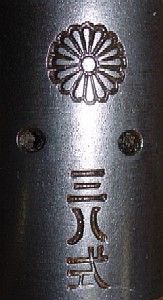- July 12, 2023
- Posted by: clakaf
- Category: Uncategorized
How to Identify and Date an Arisaka Type 38 Rifle by Serial Number
Arisaka rifles are Japanese firearms that were used by the Imperial Japanese Army and Navy during World War II. They were named after Colonel Nariakira Arisaka, who designed the Type 30 rifle. Arisaka rifles are collectible firearms today, but they can be difficult to identify and date due to their variations and markings.
In this article, we will focus on the Type 38 rifle, which was the standard infantry rifle of the Imperial Japanese Army from 1905 until the end of World War II. The Type 38 rifle was chambered for the 6.5x50mm Arisaka cartridge and had a five-round magazine. The Type 38 rifle had a dust cover over the action, a bayonet lug on the barrel, and a rear sight with two leafs. The Type 38 rifle had several variants, such as the carbine, the cavalry carbine, the sniper rifle, and the short rifle.
To identify and date an Arisaka Type 38 rifle by serial number, you need to look for the following features:
- A Chrysanthemum flower on the receiver: this was the symbol of the Japanese emperor and was present on all Arisaka rifles. However, some rifles had their Chrysanthemum flowers removed or defaced after Japan’s surrender, either by the Japanese themselves or by the Allied forces. A Chrysanthemum flower on the receiver indicates that the rifle was not surrendered or captured.
- A series mark on the left side of the receiver: this was a letter or a symbol that indicated which series of production the rifle belonged to. The series mark can help you determine which arsenal produced the rifle and when it was made. For example, a series mark of “B” indicates that the rifle was made by Tokyo Arsenal between 1933 and 1936.
- A serial number on the left side of the receiver: this was a number that indicated which rifle in a series it was. The serial number can help you determine how many rifles were produced in a series and how rare your rifle is. For example, a serial number of “333972” indicates that it was the 333,972nd rifle in its series.
By using these features, you can identify and date an Arisaka Type 38 rifle by serial number. For example, a Type 38 rifle with a Chrysanthemum flower, a series mark of “B”, and a serial number of “333972” would be identified as a Tokyo Arsenal production from 1933 to 1936 that was not surrendered or captured.
Description and Variant Types
The Type 38 rifle was a bolt-action rifle that had a length of 1,275 mm (50.2 in) and a barrel length of 797 mm (31.4 in). The rifle weighed 4.19 kg (9 lb 4 oz) and had a five-round internal magazine that was reloaded via stripper clips. The rifle had a dust cover over the action, a bayonet lug on the barrel, and a rear sight with two leafs. The upper leaf was for long-range shooting, and the lower leaf was for close-range shooting.
The Type 38 rifle had several variants, such as the carbine, the cavalry carbine, the sniper rifle, and the short rifle. The carbine was a shorter and lighter version of the rifle, with a length of 966 mm (38.0 in) and a barrel length of 487 mm (19.2 in). The carbine weighed 3.3 kg (7 lb 4 oz) and had a folding bayonet attached to the right side of the barrel. The cavalry carbine was similar to the carbine, but had a folding spike bayonet instead of a folding knife bayonet.
The sniper rifle was a modified version of the rifle, with a telescopic sight mounted on the left side of the receiver. The sniper rifle had a length of 1,280 mm (50.4 in) and a barrel length of 800 mm (31.5 in). The sniper rifle weighed 4.5 kg (9 lb 15 oz) and had a four-power scope with crosshair reticles. The short rifle was a variant of the rifle that was produced for export to China and Thailand. The short rifle had a length of 1,110 mm (43.7 in) and a barrel length of 635 mm (25.0 in). The short rifle weighed 3.8 kg (8 lb 6 oz) and had no dust cover or monopod.
Markings and Production Data
The Type 38 rifle had various markings on the receiver, barrel, and stock that indicated its origin and history. The most important marking was the Chrysanthemum flower, which was the symbol of the Japanese emperor and was stamped on the receiver of all rifles manufactured for the Imperial Japanese Army. The Chrysanthemum flower indicated that the rifle belonged to the emperor and was a sign of loyalty and honor. However, some rifles had their Chrysanthemum flowers removed or defaced after Japan’s surrender in 1945, either by the Japanese themselves or by the Allied forces. A Chrysanthemum flower on the receiver indicates that the rifle was not surrendered or captured.
Another important marking was the series mark, which was a letter or a symbol that indicated which series of production the rifle belonged to. The series mark was stamped on the left side of the receiver, next to the serial number. The series mark can help identify which arsenal produced the rifle and when it was made. For example, a series mark of “B” indicates that the rifle was made by Tokyo Arsenal between 1933 and 1936. The following table shows some of the common series marks and their meanings.
| Series Mark | Arsenal | Production Years | |||||||||||||||||
|---|---|---|---|---|---|---|---|---|---|---|---|---|---|---|---|---|---|---|---|
| A | Tokyo | 1923-1933 | |||||||||||||||||
| B | Tokyo | 1933-1936 | |||||||||||||||||
| C | Tokyo | 1936-1939 | |||||||||||||||||
| D | Tokyo | 1939-1940 | |||||||||||||||||
| E | Tokyo | 1940-1941 | |||||||||||||||||
| F | Tokyo | 1941-1942 | |||||||||||||||||
| G | Tokyo | 1942-1943 | |||||||||||||||||
| H | Tokyo | 1943-1944 | |||||||||||||||||
| I | Tokyo | 1944-1945 | |||||||||||||||||
| Ki (木) | Kokura | 1927-1935 | |||||||||||||||||
| Ri (里) | Kokura/Nagoya | 1935-1939 | |||||||||||||||||
| Version | Bullet Weight | Powder Charge | Muzzle Velocity | Muzzle Energy |
|---|---|---|---|---|
| Type 30 | 10.4 g (160 gr) | 33 grains (2.1 g) | 670 m/s (2,200 ft/s) | 2,375 J (1,752 ft⋅lbf) |
| Type 38 | 9.0 g (139 gr) | 33 grains (2.1 g) | 770 m/s (2,500 ft/s) | 2,673 J (1,971 ft⋅lbf) |
| Type 92 | 9.0 g (139 gr) | 36 grains (2.3 g) | 800 m/s (2,600 ft/s) | 2,880 J (2,124 ft⋅lbf) |
Conclusion
The Type 38 rifle was a bolt-action service rifle that was used by the Empire of Japan during the early 20th century. It was a reliable and accurate rifle that fired the 6.5×50mm Arisaka cartridge, which had various versions and modifications over the years. The Type 38 rifle had several variants and features that distinguished it from other rifles of its time, such as the Chrysanthemum flower, the series mark, and the dust cover. The Type 38 rifle is a valuable and collectible firearm today, especially if it has the original markings and accessories intact. The Type 38 rifle is a fascinating piece of history that reflects the culture and technology of Japan during its imperial era.
https://github.com/anargali/flujo-para-branches/blob/master/images/IVT%20BlueSoleil%202.6.0.8%20Full%20Version%20The%20Latest%20Update%20and%20Improvements.md
https://github.com/7uatforZcogpa/Stockfish/blob/master/.github/Victory%20Road%20Torrent%20Download%20[Patch]%20-%20High%20Quality%20Graphics%20and%20Sound.md
https://github.com/0botaspirwo/whatlang-rs/blob/master/src/combined/Money%20Hai%20Toh%20Honey%20Hai%20Full%20Movie%20In%20Hindi%20720p%20Download.md
https://github.com/0neuvesumpgo/gopeed/blob/main/internal/controller/Cracked%20Dc%20Unlocker%202%20Client%20100%200930%20Free%20426%20Compatible%20with%20All%20Major%20Brands%20and%20Models%20of%20Modems.md
https://github.com/turfiMrira/HEAD/blob/master/.github/James%20Bond%20007%20Quantum%20of%20Solace%20Crack%20Patch%20The%20Latest%20Version%20and%20Updates.md
https://github.com/serhorQpropro/link-check/blob/master/bin/What%20You%20Need%20to%20Know%20About%20CRACK%20Digital%20Media%20Group%20Facebook%20Blaster%20Pro%20V7.1.9%20Portable.md
https://github.com/diaprinzergca/Final2x/blob/main/resources/Magix%20Sound%20Forge%20Pro%20Suite%2012%201%200%20170%20(x64)%20Serial%20Key%20Comparison%20with%20Other%20Audio%20Editing%20Tools.md
https://github.com/anargali/flujo-para-branches/blob/master/images/Heroes%20of%20Might%20and%20Magic%205%20Full%20Game%20Download%20Melding%20Classic%20Deep%20Fantasy%20with%20Next-Generation%20Visuals%20and%20Gameplay.md
https://github.com/probdisYciyo/startpage/blob/master/fonts/woff2/Titan%20Quest%20Anniversary%20Edition%20(v2.3.0.5)%20[GOG]%20Game%20Hack%20Download%20and%20Install%20Guide.md
https://github.com/anargali/flujo-para-branches/blob/master/images/Herido%20pero%20aun%20caminando%20ruben%20hernandez%20pdf%2017%20Un%20libro%20de%20motivacin%20y%20esperanza%20para%20los%20que%20sufren.md
86646a7979

